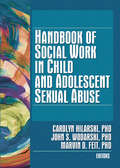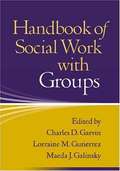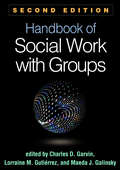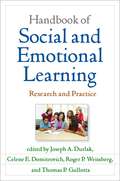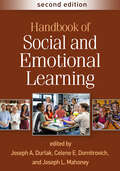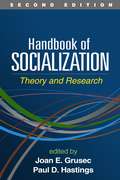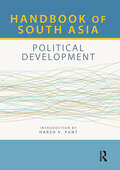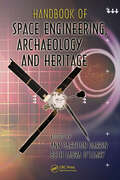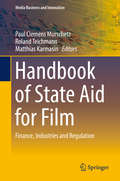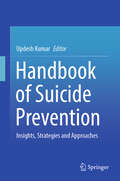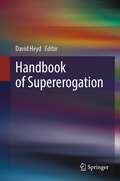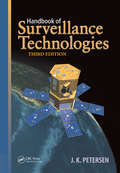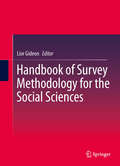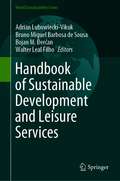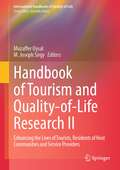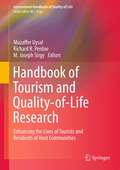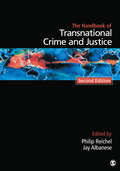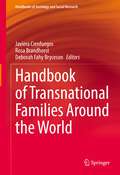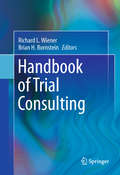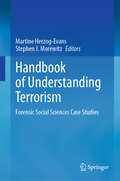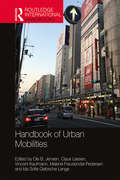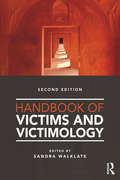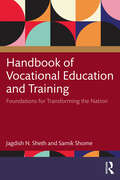- Table View
- List View
Handbook of Social Work in Child and Adolescent Sexual Abuse
by John S. Wodarski Marvin D. Feit Carolyn HilarskiThe enlightening collection of new approaches to understanding sexual abuseWhen sexual abuse occurs, helping those directly affected can be a difficult and convoluted task. The Handbook of Social Work in Child & Adolescent Sexual Abuse is a comprehensive guide that provides the latest information on assessment, management, prevention, and policy. Through insightful and accessible discussions, this collection of essays encompasses the full spectrum of child and adolescent sexual abuse to shed needed light on an affecting issue. This innovative text is the up-to-date source for unique and compassionate ways of supporting and treating survivors.The increased attention given to child sexual abuse in recent years has revealed how little we know about this tragedy. The Handbook of Social Work in Child & Adolescent Sexual Abuse is the practical compendium that covers the already existing information regarding violence against children and delves into practical methods for treating those immediately affected by it. From its historical place in society to contemporary issues of prevention that have only recently come to light, contributors examine essential details in-depth and provide concise, empirical directions for short- and long-term support. Also included is the important and newly-available assessment and treatment information focusing on ethnicity, gender, and comorbid influences as they relate to family member treatment.Among the topics discussed in the Handbook of Social Work in Child & Adolescent Sexual Abuse are: historical views of and responses to sexual abuse risk and protective factors life stage consequences theories of family dysfunction comorbidity and attachment intrafamilial abuse the non-family offender current empirical assessment methods approaches to treatment in children approaches to treatment in adolescents neurological effects of abuse treatment for the non-offending caregiver the role of the internet and other media policy and practice implications the prevalence and consequences of abuse new methods of abuse prevention and child protection the etiology of sexual offending in an attachment framework and much more!The Handbook of Social Work in Child & Adolescent Sexual Abuse is an essential resource for educators, medical practitioners, psychologists, psychiatrists, social workers, counselors, family therapists, and students, researchers, and academics in the field of social work.
Handbook of Social Work with Groups
by Charles D. Garvin Maeda J. Galinsky Lorraine M. GutierrezGarvin (social work, University of Michigan) presents work by contributors in social work and public health describing current approaches to working with groups in a range of settings and for a variety of purposes. Authors outline influential theories of group work, reviewing findings from across the social and behavioral sciences, and address contemporary issues in planning and implementing interventions in areas including mental health, child welfare, substance abuse, aging, and corrections. They also look at community groups, groups in agencies, and policymaking groups. For each approach described, authors review relevant literature, provide practical information, assess the approach from the standpoint of empowerment, and consider issues specific to working with diverse populations. Several chapters are devoted to research issues. Annotation ©2004 Book News, Inc., Portland, OR (booknews.com)
Handbook of Social Work with Groups, Second Edition
by Charles D. Garvin Maeda J. Galinsky Lorraine M. GutiérrezThis definitive text, now revised and expanded, has introduced thousands of students and practitioners to the theory and practice of social work with groups. Leading authorities outline major models of group work and address critical issues in planning, implementing, and evaluating interventions. The Handbook describes applications in all the major practice settings--mental health, prevention, child welfare, substance abuse, health care, aging, corrections, and more--as well as organizational and community settings. A strong focus on empowerment, social justice, and diversity is woven throughout. The empirical foundations of group work are reviewed, and innovative research methods discussed. New to This Edition: *Incorporates over a decade of advances in the field *Heightened focus on practitioner-researcher collaboration. *Two chapters on substance abuse prevention with youth. *Chapters on social justice work, evidence-based practice, offender reentry, intimate partner violence, intergroup dialogue, working with immigrants and refugees, qualitative methods, and intervention research. *Major updates on existing topics, such as cognitive-behavioral group work, psychoeducational groups, health care settings, and technology-mediated groups. *Integrative epilogue that synthesizes key themes.
Handbook of Social and Emotional Learning
by Daniel Goleman James P. Comer Thomas P. Gullotta Linda Darling-Hammond Celene E. Domitrovich Roger P. Weissberg Timothy P. Shriver Jennifer Buffett Joseph A. DurlakThe burgeoning multidisciplinary field of social and emotional learning (SEL) now has a comprehensive and definitive handbook covering all aspects of research, practice, and policy. The prominent editors and contributors describe state-of-the-art intervention and prevention programs designed to build students' skills for managing emotions, showing concern for others, making responsible decisions, and forming positive relationships. Conceptual and scientific underpinnings of SEL are explored and its relationship to children's and adolescents' academic success and mental health examined. Issues in implementing and assessing SEL programs in diverse educational settings are analyzed in depth, including the roles of school- and district-level leadership, teacher training, and school-family partnerships.
Handbook of Social and Emotional Learning
by The Weissberg ScholarsThe definitive work on social and emotional learning (SEL) research and practice is now in an extensively revised second edition, featuring all-new and thoroughly updated chapters. The world&’s leading SEL scholars describe state-of-the-art interventions that build students' competencies for managing emotions, showing empathy for others, forming supportive relationships, and making responsible decisions. The scientific underpinnings of SEL are explored and its impact on academic achievement and behavior is examined. The Handbook discusses ways to assess SEL and design effective, developmentally and culturally informed programs for students in preschool through secondary school settings and beyond. New to This Edition *Reflects a decade of significant advances in research, policy, and implementation. *New and expanded topics--equity, culturally responsive practice, multi-tiered systems of support, adult SEL, technology tools and applications, mental health, scaling up successful interventions, and more. *Six chapters on international SEL efforts, discussing both developed and developing countries. *Every chapter concludes with Key Takeaway Points.
Handbook of Socialization, Second Edition
by Joan E. Grusec Paul D. HastingsThis highly regarded handbook remains the leading reference and advanced text on socialization. Bringing together foremost authorities, the volume reviews the breadth of current knowledge on socialization processes across the lifespan. Contributors present cutting-edge theories and findings pertaining to family, peer, school, community, media, and other influences on individual development. Genetics and biology, cultural psychology, and affective science are given particular attention. Three themes guide the book: the interdependence of biology and experience, the bidirectionality of socialization processes, and the many contributing factors that interact to produce multiple socialization processes and pathways. New to This Edition *Revised structure reflects the diversity of socializing relationships in multiple contexts across the lifespan. *Chapters on adolescence, socialization in the workplace, moral development, culture, and neuroscience. *Many new authors and extensively revised chapters.
Handbook of South Asia: Political Development
This Handbook brings together essays that introduce the reader to the key issues in South Asian political development. Written by experts in their respective areas, the essays explore key aspects of political economy, political and economic change, and the complex diplomatic and security challenges of individual countries and the region as a whole. Essays discuss topics as wide-ranging as China’s growing reach in South Asia, political Islam, SAARC and water politics through the region. This well-researched Handbook is an essential reference tool for students and scholars of Political Science, International Relations and South Asian studies.With an introduction by Harsh V Pant.
Handbook of Space Engineering, Archaeology, and Heritage (Advances in Engineering Series)
by Beth Laura O’Leary Ann Garrison DarrinSome might think that the 27 thousand tons of material launched by earthlings into outer space is nothing more than floating piles of debris. However, when looking at these artifacts through the eyes of historians and anthropologists, instead of celestial pollution, they are seen as links to human history and heritage.Space: The New Frontier for Ar
Handbook of State Aid for Film: Finance, Industries And Regulation (Media Business and Innovation Ser.)
by Matthias Karmasin Paul Clemens Murschetz Roland TeichmannThis book is an analysis of the specificities of public film funding on an international scale. It shows how public funding schemes add value to film-making and other audio-visual productions and provides a comprehensive analysis of today’s global challenges in the film industry such as industry change, digital transformation, and shifting audience tastes. Based on insights from fields such as cultural economics, media economics, media management and media governance studies, the authors illustrate how public spending shapes the financial fitness of national and international film industries. This highly informative book will help both scholars and practitioners in the film industry to understand the complexity of issues and the requirements necessary to preserve the social benefits of film as an important cultural good.
Handbook of Suicide Prevention: Insights, Strategies and Approaches
by Updesh KumarThe Handbook of Suicide Prevention covers a broad range of topics related to suicidal behaviour, including its underlying causes, risk factors, prevention strategies, and therapeutic approaches. With contributions by renowned experts in the field, the volume brings forth the latest research and clinical insights into suicidal behaviour. It highlights evidence-based practices effective in reducing suicide risk. It provides a comprehensive overview of the multidimensional perspectives, including biological, psychological, and social factors contributing to suicidal ideation and behaviour. The book provides a nuanced and extensive understanding of how suicide risk and protective factors are shaped by social, cultural, and political contexts across the lifespan. The last section of the volume highlights the need for a multifaceted approach to suicide prevention by leveraging the latest technologies and therapeutic modalities while also addressing the social and cultural factors that contribute to suicide risk. Suicidal behaviour remains an intriguing phenomenon that demands addressing being among the leading causes of death worldwide. The handbook is a compilation of essential resources that offers a multitude of theoretical and compassionate approaches to understanding and addressing this complex phenomenon. Its practical guidance and evidence-based recommendations make it an essential reference for anyone working in suicide prevention, mental health and social work.
Handbook of Supererogation
by David HeydSupererogation is the category of moral actions which go beyond the call of duty. This collection of articles is the first of its kind to cover the broad spectrum of issues related to supererogation. It provides an up-to-date status of the discussion on the main issues, alternative analyses, and controversies regarding central cases of supererogation. The work explores a broad range of philosophical problems and challenges our presuppositions about the basis of ethical theories. Beyond the challenges of supererogation to deontological and utilitarian views, this book presents the latest developments in the way virtue ethics approaches supererogation. It also discusses the issue of whether there is a negative analogue to the supererogatory: the suberogatory. The Handbook consists also of the first systematic discussion of supererogation from the point of view of five religions as well as a feminist analysis of the concept. The book is an essential read for philosophy scholars interested in moral philosophy.
Handbook of Surveillance Technologies
by J.K. Petersen Pamela TaylorFrom officially sanctioned, high-tech operations to budget spy cameras and cell phone video, this updated and expanded edition of a bestselling handbook reflects the rapid and significant growth of the surveillance industry. The Handbook of Surveillance Technologies, Third Edition is the only comprehensive work to chronicle the background and curre
Handbook of Survey Methodology for the Social Sciences
by Lior GideonSurveys enjoy great ubiquity among data collection methods in social research: they are flexible in questioning techniques, in the amount of questions asked, in the topics covered, and in the various ways of interactions with respondents. Surveys are also the preferred method by many researchers in the social sciences due to their ability to provide quick profiles and results. Because they are so commonly used and fairly easy to administer, surveys are often thought to be easily thrown together. But designing an effective survey that yields reliable and valid results takes more than merely asking questions and waiting for the answers to arrive. Geared to the non-statistician, the Handbook of Survey Methodology in Social Sciences addresses issues throughout all phases of survey design and implementation. Chapters examine the major survey methods of data collection, providing expert guidelines for asking targeted questions, improving accuracy and quality of responses, while reducing sampling and non-sampling bias. Relying on the Total Survey Error theory, various issues of both sampling and non-sampling sources of error are explored and discussed. By covering all aspects of the topic, the Handbook is suited to readers taking their first steps in survey methodology, as well as to those already involved in survey design and execution, and to those currently in training. Featured in the Handbook: * The Total Survey Error: sampling and non-sampling errors. * Survey sampling techniques. * The art of question phrasing. * Techniques for increasing response rates * A question of ethics: what is allowed in survey research? * Survey design: face-to-face, phone, mail, e-mail, online, computer-assisted.? * Dealing with sensitive issues in surveys. * Demographics of respondents: implications for future survey research. * Dealing with nonresponse, and nonresponse bias The Handbook of Survey Methodology in Social Sciences offers how-to clarity for researchers in the social and behavioral sciences and related disciplines, including sociology, criminology, criminal justice, social psychology, education, public health, political science, management, and many other disciplines relying on survey methodology as one of their main data collection tools.
Handbook of Sustainable Development and Leisure Services (World Sustainability Series)
by Walter Leal Filho Adrian Lubowiecki-Vikuk Bruno Miguel Barbosa de Sousa Bojan M. ĐerčanThis book reviews empirical and theoretical research on sustainable development in the context of leisure management for communities. Although leading research centers are pursuing interdisciplinary research on leisure in the context of sustainable development, there are still few papers that holistically address the current challenges in this area. In addition, demographic changes have made the promotion of a healthy lifestyle essential. Doing so requires responsible behavior on the part of various stakeholders in this market.This book fills an important gap in the literature and gathers contributions from an interdisciplinary and international team of authors, whose fields of expertise include human geography, management, intersections of sustainability and leisure, behavioral psychology and tourism.
Handbook of Tourism and Quality-of-Life Research II: Enhancing the Lives of Tourists, Residents of Host Communities and Service Providers (International Handbooks of Quality-of-Life)
by Muzaffer Uysal M. Joseph SirgyThe second volume of this handbook develops on and extends the discussion in the successful first volume, published in 2012. This is a timely addition to the literature, drawing on the momentum that quality of life (QOL) research in tourism has gained in the 21st century and on the boom in the tourism industry itself. It focuses on four areas of growth in QOL research in the recent past: (1) travelers/tourists, (2) host communities, (3) service providers, and (4) the role of technology. The handbook helps management of tourism firms and policy makers develop specific policies and programs to ensure the most positive impact of tourism on tourists, host communities, and service providers. The comprehensive coverage of topics in this handbook makes it a state-of-the-art reference. Academics interested in QOL research in travel and tourism, tourism practitioners interested in applying the science of QOL in the tourism industry, as well as policy makers involved in regulating the industry will view the handbook as indispensable source of recent research.
Handbook of Tourism and Quality-of-Life Research: Enhancing the Lives of Tourists and Residents of Host Communities
by Muzaffer Uysal M. Joseph Sirgy Richard PerdueQuality of life (QOL) research in tourism has gained much momentum over the last two decades. Academics working in this area research issues related to tourists and host communities. Practitioners are becoming increasingly interested in understanding the science that allows them to develop better marketing and managerial programs designed to enhance the quality of life of tourists. Tourism bureaus and government agencies are increasingly interested in issues of sustainable tourism, specifically in understanding and measuring the impact of tourism on the quality of life of the residents of the host communities. This handbook covers all relevant topics and is divided into two parts: research relating to travelers/tourists, and research relating to the residents of host communities. It is the only state-of-the-art reference book in its field and will prove invaluable to academics interested in QOL research, as well as tourism practitioners interested in applying the science of QOL in the tourism industry.
Handbook of Transnational Crime and Justice
by Jay S. Albanese Philip L. ReichelTransnational crime and justice will characterize the 21st century in same way that traditional street crimes dominated the 20th century. In the Handbook of Transnational Crime and Justice, Philip Reichel and Jay Albanese bring together top scholars from around the world to offer perspectives on the laws, crimes, and criminal justice responses to transnational crime. This concise, reader-friendly handbook is organized logically around four major themes: the problem of transnational crime; analysis of specific transnational crimes; approaches to its control; and regional geographical analyses. Each comprehensive chapter is designed to be explored as a stand-alone topic, making this handbook an important textbook and reference tool for students and practitioners alike.
Handbook of Transnational Families Around the World (Handbooks of Sociology and Social Research)
by Deborah Fahy Bryceson Javiera Cienfuegos Rosa BrandhorstThis handbook compiles the most up-to-date research on transnational families. It employs a dialogue between classical approaches and cutting-edge directions in transnational family research to identify continuities and changes in terms of socioeconomic disparities and actors, and to analyze coexistence. Further, the volume adopts a twofold global and international comparative perspective. On the one hand, it focuses on different migratory flows around the world and describes their entangled logics; on the other, it is written by an international group of contributors, with a diverse range of professional backgrounds. Their contributions are based on sound empirical research, and explore geographical regions around the world. The handbook presents different thematic perspectives on transnational families, including an analytical focus on gender, global sociodemographic inequalities, power asymmetries, and border- and mobility regimes, as well as the organization of transnational care, transnational fatherhood, ageing, family reunions and return. It also includes a variety of methodological approaches to transnational family research, ranging from ethnography, biographical research, and life-course methods, to multi-sited approaches and quantitative surveys. Investigating an emergent debate, it sheds new light on migratory fluxes, their common and specific determinants, the types of actors involved, and ways to empirically and methodologically approach them. This is a must-read reference for social scientists interested in family research, migration, and gender studies. Chapter 7 is available open access under a Creative Commons Attribution 4.0 International License via link.springer.com.
Handbook of Treatment Planning for Children with Autism and Other Neurodevelopmental Disorders (Autism and Child Psychopathology Series)
by Pamela McPhersonThis handbook addresses treatment planning for children with autism spectrum disorder (ASD) and other neurodevelopmental disabilities (NDDs) using a medical home perspective. It examines the medical home model, which has been promoted as the standard of care by the American Academy of Pediatrics since 2002, emphasizing collaboration between patients, families, and providers to optimize care. The handbook addresses treatment planning, including the coordination of the care provided by multiple specialists with a clear, shared vision for maximizing each child’s potential.Key areas of coverage include:· Elements of treatment planning, history of the medical home model, documentation, and strategies to facilitate communication.· Goals of treatment from the perspectives of the family, person served, care providers, and fiscal and regulatory bodies.· Role of each specialist, highlighting the most common conditions experienced by children with ASD and other NDD with expectations for assessment and treatment.· Detailed recommendations for making referrals and assisting the child and family in preparing for appointments.The Handbook of Treatment Planning for Children with Autism Spectrum Disorder and Other Neurodevelopmental Disabilities is a must-have resource for researchers, professors, and graduate students as well as clinicians, therapists, and other professionals across such interrelated disciplines as clinical child, school, and developmental psychology, child and adolescent psychiatry, social work, rehabilitation medicine/therapy, pediatrics, and special education.
Handbook of Trial Consulting
by Brian H. Bornstein Richard L. WienerThis volume will be a handbook that treats trial consulting as applied psychology. The purpose of the volume will be to collect the viewpoints of leaders in the field of psychology and law who apply the discipline's theoretical models, methods, and ethics to assist litigators to try cases in the most effective way possible. As a whole, the collection of chapters will describe the theory, business, and mechanics of trial consulting for those interested in learning and practicing the profession. However, it will do so from the perspective of organized theories of jury-decision making. In other words, the work of juror researchers will inform the recommendations and suggestions in the handbook. The volume consists of six sections, each pertaining to a different topic. Multiple chapters with different authors will cover each topic. The topics and corresponding seven sections will be 1) An Introduction to the Theory and Psychology of Jury Decision-Making, 2) Applied Research Methodologies for Trial Consultants, 3) Education and Ethical Considerations for Trial Consultants, 4) Preparing and Cross Examining Witnesses, 5) Technology and Demonstrative Evidence at Trial, and 6) Special Topics in Trial Consulting. Each section will begin with the editors' short introduction reviewing that section and explaining its goals, objectives, and content. Separate individuals, recognized as leaders in their areas will write the remaining chapters in each section. These individuals come from the fields of both psychology and law, and represent viewpoints on these topics from a practice-oriented perspective, but a perspective that is emerges from research results. They are affiliated with a number of academic institutions, including University of Nebraska, John Jay College of Criminal Justice, University of Texas, University of Chicago Simon Fraser University, and private law firms.
Handbook of Understanding Terrorism: Forensic Social Sciences Case Studies
by Stephen J. Morewitz Martine Herzog-EvansThis book examines common theoretical conceptualization of terrorism, including all the following dimensions: Macro-criminological theories Psycho-criminological models of aggression Psycho-criminological models of risk and need (RNR) Psychopathology Social psychology, particularly in the areas of intergroup relations, identity, need for closure, and, the quest for significance Ideological and religious passions and extremism International in scope, each chapter draws on a combination of these frameworks, exemplified in a collection of case series and studies, to help students, practitioners, and researchers better understand these phenomena.
Handbook of Urban Mobilities (Routledge International Handbooks)
by Ole B. JensenThis book offers the reader a comprehensive understanding and the multitude of methods utilized in the research of urban mobilities with cities and ‘the urban’ as its pivotal axis. It covers theories and concepts for scholars and researchers to understand, observe and analyse the world of urban mobilities. The Handbook of Urban Mobilities facilitates the understanding of urban mobilities within a historic conscience of societal transformation. It explores key concepts and theories within the ‘mobilities turn’ with a particular urban framework, as well as the methods and tools at play when empirical, urban mobilities research is undertaken. This book also explores the urban mobilities practices related to commutes; particular modes of moving; the exploration of everyday life and embodied practices as they manifest themselves within urban mobilities; and the themes of power, conflict, and social exclusion. A discussion of urban planning, public control, and governance is also undertaken in the book, wherein the themes of infrastructures, technologies and design are duly considered. With chapters written in an accessible style, this handbook carries timely contributions within the contemporary state of the art of urban mobilities research. It will thus be useful for academics and students of graduate programmes and post-graduate studies within disciplines such as urban geography, political science, sociology, anthropology, urban planning, traffic and transportation planning, and architecture and urban design.
Handbook of Victims and Victimology
by Sandra WalklateThe study of criminal victimisation has developed to the stage where by victimology is now regarded as a central component to the study of crime and criminology. This focus of concern has been matched by the growth and development of support services for the victim of crime alongside increasing political concern with similar issues. The central purpose of this book is to bring together leading scholars to produce an authoritative handbook on victims and victimology that gives due consideration to these developments. It will be concerned to reflect contemporary academic, policy, and political debates on the nature, extent and impact of criminal victimisation and policy responses to it. This book provides a overview of the importance of the role of the victim in the criminal justice system, with an analysis of the different theoretical perspectives within victimology. explores the relationship between victimisation and feminism with particular focus on domestic and sexual violence. analyses criminal justice policy and service delivery in relation to victims of crime, looking at developments within the UK and international perspectives. This handbook will be fundamental reading for students and academics studying victims and victimology and an essential reference tool for those working within the victim support environment.
Handbook of Victims and Victimology
by Sandra WalklateThis second edition of the Handbook of Victims and Victimology presents a comprehensively revised and updated set of essays, bringing together internationally recognised scholars and practitioners to offer substantial research informed overviews within their specialist fields of investigation. This handbook is divided into five parts, with each part addressing a different theme within victimology: Part I offers a scene-setting exploration of new developments in the field, enduring issues that remain relatively unchanged and the gaps and traps within the contemporary victimological agenda Part II examines of the complex dimensions to victim experiences as structured by gender, age, ethnicity, sexuality and intersectionality Part III reflects on the problems and possibilities of formulating policy responses in the light of the changing appreciation of the nature and extent of victimhood Part IV focused on the value of a comparative lens and the problems and possibilities of victim policies when seen through this lens, explored along three geographical axes: Europe, Australia and Asia Part V considers other ways of thinking about who counts as a victim and what counts as victimhood and extends the boundaries of the victimological imagination outward Building on the success of the previous edition, this book provides an international focus on cutting-edge issues in the field of victimology. Including brand new chapters on intersectionality, child victims, sexuality, hate crime and crimes of the powerful, this handbook is essential reading for students and academics studying victims and victimology and an essential reference tool for those working within the victim support environment.
Handbook of Vocational Education and Training: Foundations for Transforming the Nation
by Jagdish N. Sheth Samik ShomeVocational education and training (VET) are major stepping stones in the development journey of any nation. A carefully structured and implemented VET system ensures skill development and equips the existing and prospective workforce with the necessary technical proficiency, thereby reducing unemployment and increasing productivity. This handbook is designed to provide the readers with a comprehensive understanding of the ways in which VET has been implemented in both highly developed and developing countries around the globe, including Germany, Japan, China, India, and countries in Africa and Latin America, among others. It looks at how VET plays a crucial role in empowering a nation, acts as a comparative advantage, and contributes to nation-building. In the process, it highlights the best practices and fallacies related to VET and showcases how effective vocational training can allow countries to confront existing deficits in employment and decent work. This detailed handbook will be of interest to policymakers, government officials, and corporate executives working in education, education policy, curriculum, teaching and learning, adult education and lifelong learning, and classroom practice. It will also be valuable to technical education students and those working with executive training programmes, public sector enterprises and NGOs related to VET.
